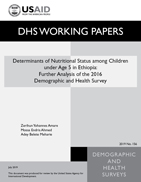
Abstract:
Background: The aim of this study was to
examine the determinants of nutritional
status among children under age 5 (0-59
months) in Ethiopia. Child malnutrition is an
underlying cause of almost half (45%) of
child deaths, particularly in low
socioeconomic communities of developing
countries. In Ethiopia, the prevalence of
stunting decreased from 47% in 2005 to 39% in
2016, but the prevalence of wasting changed
little over the same time period (from 11% to
10%). Despite improvements in reducing the
prevalence of malnutrition, the current rate
of progress is not fast enough to reach the
World Health Organization global target for
reducing malnutrition 40% by 2025.
Methods: This study used data from the 2016
Ethiopia Demographic and Heath Survey (EDHS).
The analysis used stunting and wasting as
dependent variables, while the independent
variables were characteristics of children,
mothers, and households. Logistic regression
was used to analyze the determinants of
nutritional status among children. Bivariate
analysis was also used to analyze the
association between the dependent and
independent variables.
Results: Study results show that child’s age,
sex, and perceived birth weight, mother’s
educational status, BMI, and maternal
stature, and region, wealth quintile, type of
toilet facility, and type of cooking fuel had
significant associations with stunting.
Child’s age, sex, and perceived birth weight,
mother’s BMI, and residence and region showed
significant associations with wasting.
Conclusions: The study found that child,
maternal, and household characteristics were
significantly associated with stunting and
wasting among children under age 5. These
findings imply that a multi-sectorial and
multidimensional approach is important to
address malnutrition in Ethiopia. The
education sector should promote reduction of
cultural and gender barriers that contribute
to childhood malnutrition. The health sector
should encourage positive behaviors toward
childcare and infant feeding practices. More
should be done to help households adopt
improved types of toilet facilities and
modern types of cooking fuels.
 Determinants of Nutritional Status among Children under Age 5 in Ethiopia: Further Analysis of the 2016 Demographic and Health Survey (PDF, 373K)
Determinants of Nutritional Status among Children under Age 5 in Ethiopia: Further Analysis of the 2016 Demographic and Health Survey (PDF, 373K)
